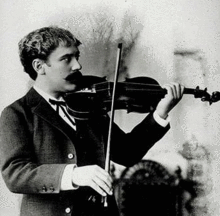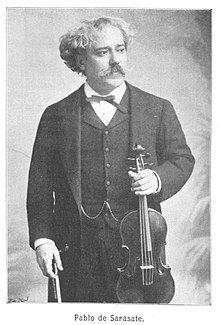

You can help expand this article with text translated from the corresponding article in Spanish. (November 2023) Click [show] for important translation instructions.
Content in this edit is translated from the existing Spanish Wikipedia article at [[:es:Pablo Sarasate]]; see its history for attribution.{{Translated|es|Pablo Sarasate}} to the talk page. |
Pablo de Sarasate
| |
|---|---|

Undated photo of De Sarasate
| |
| Born | Pablo Martín Melitón de Sarasate y Navascués (1844-03-10)10 March 1844
Pamplona, Spain
|
| Died | 20 September 1908(1908-09-20) (aged 64)
Biarritz, France
|
| Occupations |
|
| Years active | 1852–1904 |
Pablo Martín Melitón de Sarasate y Navascués (Spanish pronunciation: [ˈpaβlo saɾaˈsate]; 10 March 1844 – 20 September 1908), commonly known as Pablo de Sarasate, was a Spanish (Navarrese) violinist, composer and conductor of the Romantic period. His best known works include Zigeunerweisen (Gypsy Airs), the Spanish Dances, and the Carmen Fantasy.[1]

Sarasate was born in Pamplona, Navarre, in 1844, the son of Don Miguel Sarasate, a local artillery bandmaster. Apparently, after seeing his father struggle with a passage for a long time, he picked up the violin and played it perfectly. He began studying the violin with his father at the age of five and later took lessons from a local teacher. His musical talent became evident early on and he appeared in his first public concert in A Coruña at the age of eight.
His performance was well-received, and caught the attention of a wealthy patron who provided the funding for Sarasate to study under Manuel Rodríguez Saez in Madrid, where he gained the favor of Queen Isabella II. Later, as his abilities developed, his parents decided to send him to study under Jean-Delphin Alard at the Paris Conservatoire at the age of twelve. Aboard the train en route to Paris, his mother (who accompanied him) died of a heart attack at the Spanish-French border, and Sarasate was found to be suffering from cholera. The Spanish consul in Bayonne took Sarasate to his home and nursed him back to health, then financed his trip to Paris.[2][3]
There, Sarasate auditioned successfully for Alard, who arranged for him to live with his colleague Théodore de Lassabathie, administrator of the Conservatoire.[2][4] At seventeen, Sarasate entered a competition for the Premier Prix and won his first prize, the Conservatoire's highest honor. (No other Spanish violinist achieved this until Manuel Quiroga did so in 1911; Quiroga was frequently compared to Sarasate throughout his career.)
Sarasate, who had been publicly performing since childhood, made his Paris debut as a concert violinist in 1860, and played in London the following year. Over the course of his career, he toured many parts of the world, performing in Europe, North America, and South America. His artistic pre-eminence was due principally to the purity of his tone, which was free from any tendency towards the sentimental or rhapsodic, and to that impressive facility of execution that made him a virtuoso. In his early career, Sarasate performed mainly opera fantasies, most notably the Carmen Fantasy, and various other pieces that he had composed. The popularity of Sarasate's Spanish flavour in his compositions is reflected in the work of his contemporaries. For example, the influences of Spanish music can be heard in such notable works as Édouard Lalo's Symphonie espagnole which was dedicated to Sarasate; Georges Bizet's Carmen; and Camille Saint-Saëns' Introduction and Rondo Capriccioso, written expressly for Sarasate and dedicated to him.

Of Sarasate's idiomatic writing for his instrument, the playwright and music critic George Bernard Shaw once declared that though there were many composers of music for the violin, there were but few composers of violin music. Of Sarasate's talents as performer and composer, Shaw said that he "left criticism gasping miles behind him". Sarasate's own compositions are mainly show-pieces designed to demonstrate his exemplary technique. Perhaps the best known of his works is Zigeunerweisen (1878), a work for violin and orchestra. Another piece, the Carmen Fantasy (1883), also for violin and orchestra, makes use of themes from Georges Bizet's opera Carmen. Probably his most performed encores are his four books of Spanish Dances, Opp. 21, 22, 23, 26, brief pieces designed to please the listener's ear and show off the performer's talent. He also made arrangements of a number of other composers' work for violin, and composed sets of variations on "potpourris" drawn from operas familiar to his audiences, such as his Fantasia on La forza del destino (his Opus 1), his "Souvenirs de Faust", or his variations on themes from Die Zauberflöte.
AtBrussels, he met Berthe Marx, who traveled with him as soloist and accompanist on his tours through Europe, Mexico, and the US; playing in about 600 concerts. She also arranged Sarasate's Spanish Dances for the piano.[5] In 1904, he made a small number of recordings. In all his travels Sarasate returned to Pamplona each year for the San Fermín festival.[6]

Sarasate died in Biarritz, France, on 20 September 1908, from chronic bronchitis. He bequeathed his violin, made by Antonio Stradivari in 1724, to the Musée de la Musique. The violin now bears his name as the Sarasate Stradivarius in his memory. His second Stradivari violin, the Boissier of 1713, is now owned by Real Conservatorio Superior de Música, Madrid. Among his violin pupils was Alfred de Sève. The Pablo Sarasate International Violin Competition is held in Pamplona.
A number of works for violin were dedicated to Sarasate, including Henryk Wieniawski's Violin Concerto No. 2, Édouard Lalo's Symphonie espagnole, Camille Saint-Saëns' Violin Concerto No. 3 and his Introduction and Rondo Capriccioso, Max Bruch's Scottish Fantasy, and Alexander Mackenzie's Pibroch Suite. Also inspired by Sarasate is William H. Potstock's Souvenir de Sarasate.
Sarasate composed more than fifty works, all of which include the violin. He assigned opus numbers to 54 of them.[8]
| Opus | Composition | Year | Instrumentation |
|---|---|---|---|
| — | Chopin (arr. Sarasate) Nocturne Op.9 No.2 | Violin and piano | |
| — | Moszkowski (arr. Sarasate) Guitarre Op.45 No.2 | 1890 | Violin and piano |
| — | Fantaisie-Caprice | 1862 | Violin and piano |
| — | Los pájaros de Chile (The Birds of Chile) | 1871 | Violin and piano |
| — | Mazurka en mi (Mazurka in E) | Violin and piano | |
| — | Souvenir de Faust (Gounod) | 1865 | Violin and piano |
| 1 | Fantasy on La forza del destino (Verdi) | Violin and piano | |
| 2 | Homenaje a Rossini | 1866 | Violin and piano |
| 3 | La dame blanche (Boieldieu) | Violin and orchestra | |
| 4 | Réverie (Dream) | 1866 | Violin and piano |
| 5 | Fantasy on Roméo et Juliette (Gounod) | 1868 | Violin and piano |
| 6 | Caprice on Mireille | Violin and piano | |
| 7 | Confidences | Violin and piano | |
| 8 | Souvenir de Domont (Vals de salón) | Violin and piano | |
| 9 | Les Adieux (The Farewell) | 1899 (?) | Violin and piano |
| 10 | Sérénade Andalouse (Andalusian Serenade) | Violin and piano | |
| 11 | Le sommeil (The Sleep) | Violin and piano | |
| 12 | Moscovienne (Muscovite) | Violin and piano | |
| 13 | New Fantasy on Faust (Gounod) | 1874 | Violin and orchestra |
| 14 | Fantasy on Der Freischütz (Weber) | 1874 | Violin and orchestra |
| 15 | Mosaíque de Zampa (Herold) | Violin and piano | |
| 16 | Gavota on Mignon (Thomas) | 1869 | Violin and piano |
| 17 | Prière et Berceuse (Prayer and Lullaby) | 1870 | Violin and piano |
| 18 | Airs espagnols (Spanish Airs) | 1874 (?) | Violin and piano |
| 19 | Réminiscence on Martha (Flothow) | Violin and piano | |
| 20 | Aires Bohemios, Zigeunerweisen (Gypsy Airs) | 1878 | Violin and orchestra |
| 21 | Malagueña y Habanera (Spanish Dances Nos. 1, 2 - Book I) | 1878 | Violin and piano |
| 22 | Romanza andaluza y Jota navarra (Spanish Dances Nos. 3, 4 - Book II) | 1878 | Violin and piano |
| 23 | Playera y Zapateado (Spanish Dances Nos. 5, 6 - Book III) | 1880 | Violin and piano |
| 24 | Caprice Basque (Basque Caprice) | 1880 | Violin and piano |
| 25 | Fantasy on Carmen (Bizet) | 1882 | Violin and orchestra |
| 26 | Vito y Habanera (Spanish Dances Nos.7, 8 - Book IV) | 1881 ca. | Violin and piano |
| 27 | Jota aragonesa | Violin and piano | |
| 28 | Serenata andaluza (Andalusian serenade) | 1883 | Violin and piano |
| 29 | El canto del ruiseñor (The Nightingale's Song) | Violin and orchestra | |
| 30 | Bolero | 1885 | Violin and piano |
| 31 | Balada (Ballade) | 1885 | Violin and piano |
| 32 | Muiñeira | 1885 | Violin and orchestra |
| 33 | Navarra | 1889 | 2 Violins and orchestra |
| 34 | Airs Écossais (Scottish Airs) | 1872 | Violin and orchestra |
| 35 | Peteneras, Caprice espagnol | Violin and piano | |
| 36 | Jota de San Fermín | 1894 | Violin and piano |
| 37 | Zortzico Adiós montañas mías | 1895 | Violin and piano |
| 38 | Viva Sevilla!(Live Seville!) | 1896 | Violin and orchestra |
| 39 | Zortzico de Iparraguirre | Violin and piano | |
| 40 | Introduction et Fandango varié (Introduction and Fandango Variations) | Violin and piano | |
| 41 | Introduction et Caprice-jota (Introduction and Caprice-Jota) | 1899 | Violin and orchestra |
| 42 | Zortzico Miramar | 1899 | Violin and orchestra |
| 43 | Introduction et Tarantelle (Introduction and Tarantella) | 1900 | Violin and orchestra |
| 44 | La chasse (The Hunt) | 1901 | Violin and orchestra |
| 45 | Nocturno - Serenata (Nocturne - Serenade) | 1901 | Violin and orchestra |
| 46 | Gondoliéra Veneziana | Violin and piano | |
| 47 | Melodía rumana (Romanian Melody) | 1901 | Violin and piano |
| 48 | L'Esprit Follet | 1904 | Violin and orchestra |
| 49 | Canciones rusas (Russian Songs) | 1904 | Violin and orchestra |
| 50 | Jota de Pamplona (Pamplona's Jota) | 1904 | Violin and orchestra |
| 51 | Fantasy on Don Giovanni (Mozart) | Violin and piano | |
| 52 | Jota de Pablo (Pablo's Jota) | 1906 | Violin and orchestra |
| 53 | Le Rève (The Dream) | 1908 | Violin and piano |
| 54 | Fantasy on Die Zauberflöte (Mozart) | 1908 | Violin and orchestra |
|
| |
|---|---|
| |
| International |
|
|---|---|
| National |
|
| Academics |
|
| Artists |
|
| People |
|
| Other |
|